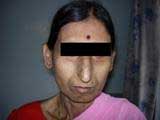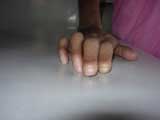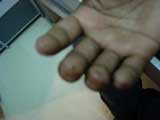 Scleroderma Face |
 Scleroderma Hand |
 Scleroderma Ulcers |
Scleroderma is an autoimmune disease with tight, thick, firm, hard, hidebound skin and the involvement of various internal organs such as lungs, gastrointestinal tract, heart, and kidneys. It is a rare disease that affects 8-15 adults per million in UK and 276 adults per million in the USA. The condition can affect children too. The exact incidence in India is not known, and it seems that milder cases remain undiagnosed. Females are affected more often (3:1) than males.
The exact cause of this disease is unknown. However, some agents such as organic solvents, hair dyes, metal dust, pesticides, drugs (bleomycin), and some viruses appear to be related to the development of skin thickening. Damage to small blood vessels is the primary event associated with their obliteration. Immune activation in the form of inflammation and the appearance of specific autoantibodies is another event. However, autoantibodies are not directly involved in the disease process. Fibrosis (an increase of scar tissue) of skin and internal organs is the final event giving rise to various problems in these patients.
Two main types of scleroderma are localized and systemic. Localized scleroderma (morphea, en coup de sabre, etc.) is usually restricted to the skin and is just a cosmetic problem. Deeper and extensive involvement in localized scleroderma can interfere with joint movements and daily activities. Localized scleroderma does not involve internal organs and is never life-threatening.
Systemic scleroderma is a multisystem disease in which skin involvement can be limited (face, neck, and beyond elbows/knees) or diffuse (generalized). It usually starts as fever, fatigue, malaise, and other generalized complaints and puffy fingers and hands, Raynaud’s phenomena (pallor of fingertips followed sequentially by blue and pink discoloration on cold exposure), and heartburn. The skin becomes thick and tight with increased or decreased skin pigmentation and decreased sweat and oil secretion (dry skin). The tightness of the skin increases slowly and leads to a peculiar facial appearance and slender, stiff fingers. Inability to open the mouth (‘mauskopf’ – mouse-like face; Ger.), extend the neck, and move fingers are frequent problems due to skin tightness in these areas. This process stops after 1-3 years, and skin becomes thinner with regrowth of hair on forearms and a decrease in tightness. Painful pitting ulcers at the tips of fingers and toes can complicate the situation as they heal very slowly, can get infected, involve bone, and may require amputation.
Organ involvement in systemic scleroderma indicates severe disease, poorer prognosis, and need for aggressive rheumatological management.
Clinical features of common organ involvements are listed below:
- Gastrointestinal - Difficulty in swallowing, heartburn, regurgitation, chronic throat irritation, shrinking of gums, loss of teeth enamel, bloating, early satiety, nausea, vomiting, change of bowel habits, constipation, pain in the abdomen
- Lungs - Dry cough, breathlessness on exertion, swelling of feet, blood in sputum
- Heart - Chest pain, fainting, dizziness, palpitations, increasing breathlessness
- Kidneys - Sudden rise in blood pressure (headache, fits, breathlessness, blurring of vision), low urine output
Scleroderma does not affect fertility or pregnancy, although pregnancy can increase the risk of complications in these patients.
Laboratory Tests
The diagnosis of scleroderma is based on clinical examination, and there is no laboratory test for establishing the diagnosis. Blood tests for auto-antibodies help in making the diagnosis, but this information may not be conclusive. In addition, many other tests are essential to diagnose and monitor organ involvement. These include tests for kidney function (urine and blood), chest X-ray, pulmonary function tests with DLCO, High-resolution CT-scan of chest, bronchoscopy, and examination of aspirated fluid, gastroscopy, esophageal manometry, Xylose breath test, treadmill stress test, echocardiography, MRI and perfusion studies of heart, Holter monitoring for the rhythm of the heart and right heart catheterization. Some of these tests may be required to be repeated during follow-up to assess response to therapy.
Treatment
There is no effective treatment that can arrest or reverse the disease. Early recognition of organ involvement is necessary to avoid life-threatening complications. Various drugs effectively control organ involvement in this disease and are, therefore, used as needed. Immunosuppressants like methotrexate and cyclophosphamide are beneficial for skin and lung involvement and are shown to improve survival. Glucocorticoids (steroids) are of no use and may precipitate life-threatening kidney disease. Good drugs are now available for the control of gastrointestinal and cardiac complications. Significant research is ongoing to develop new therapies. Hemopoietic Stem Cell Transplant has shown encouraging results in properly selected cases.
Patients with Raynaud’s phenomena and fingertip ulcers must stop smoking, protect from cold exposure (wear gloves and socks) and keep them warm. Protection of skin from trauma is essential. Skin must be adequately hydrated (use moisturizers), washed carefully, and properly disinfected. The ulcers should be kept open as blocking gas exchange causes a ‘greenhouse effect’ and delays healing.
